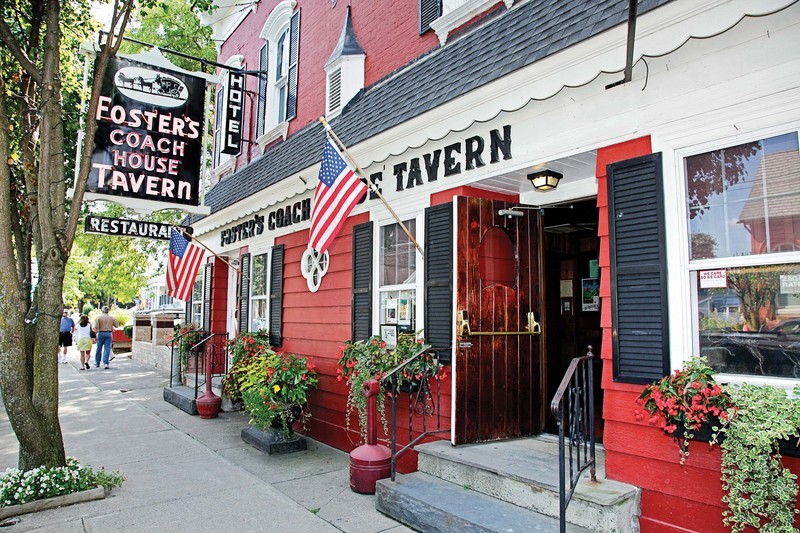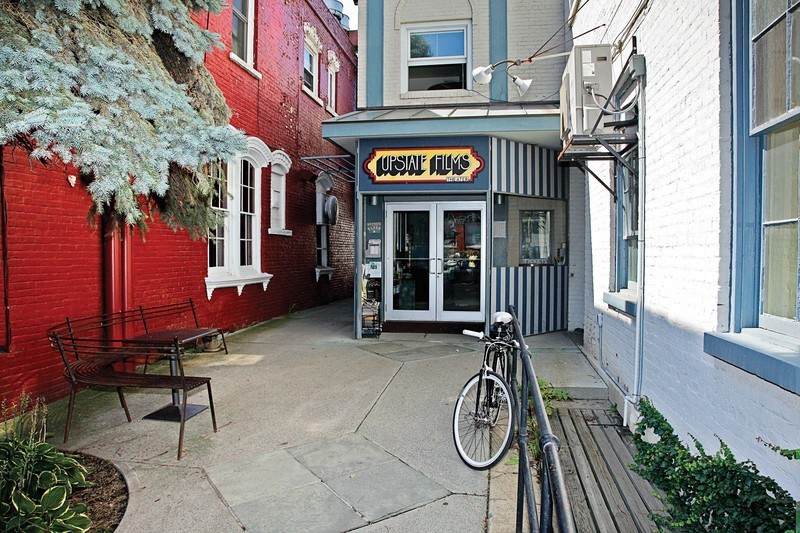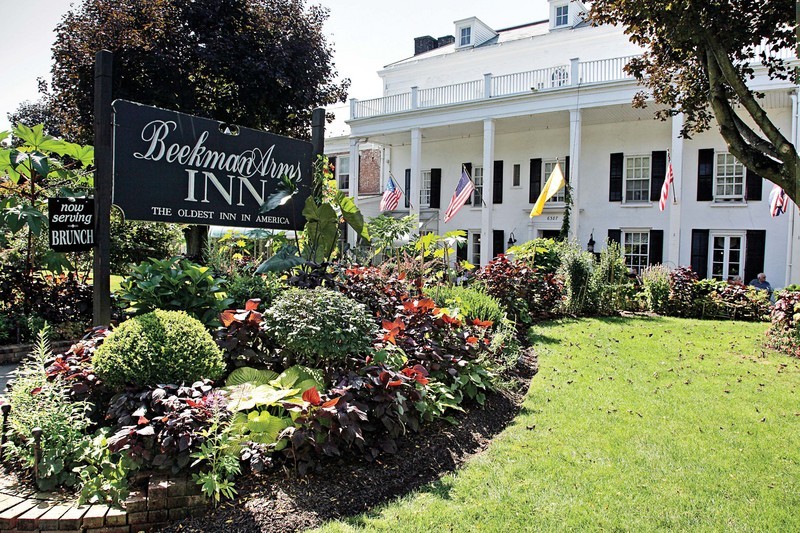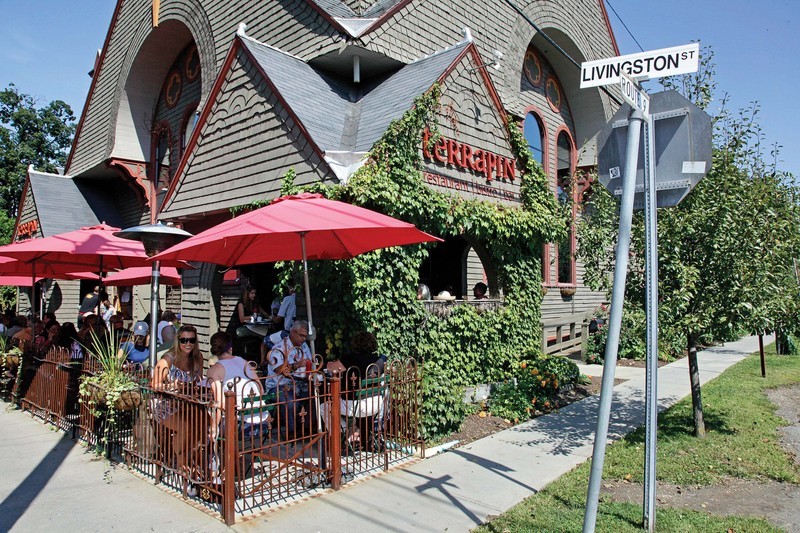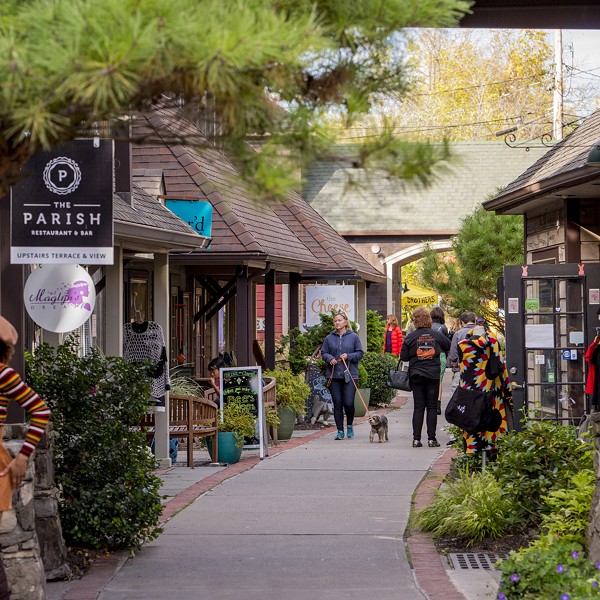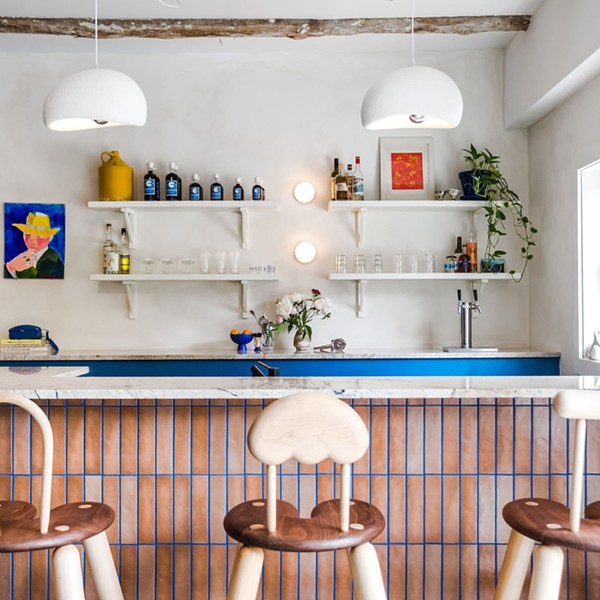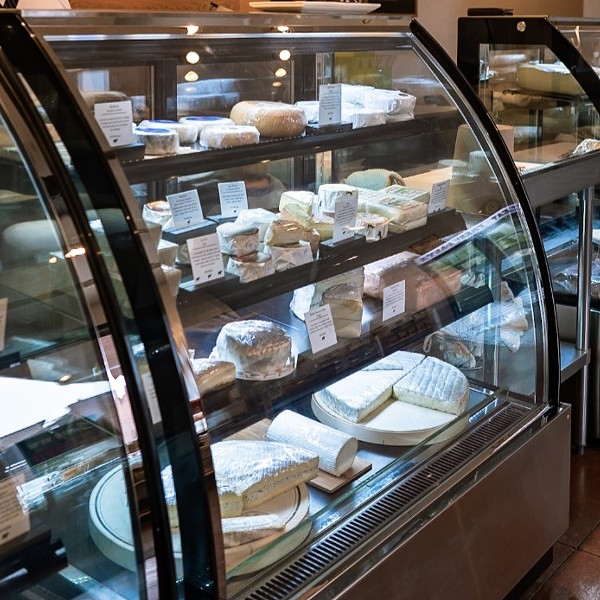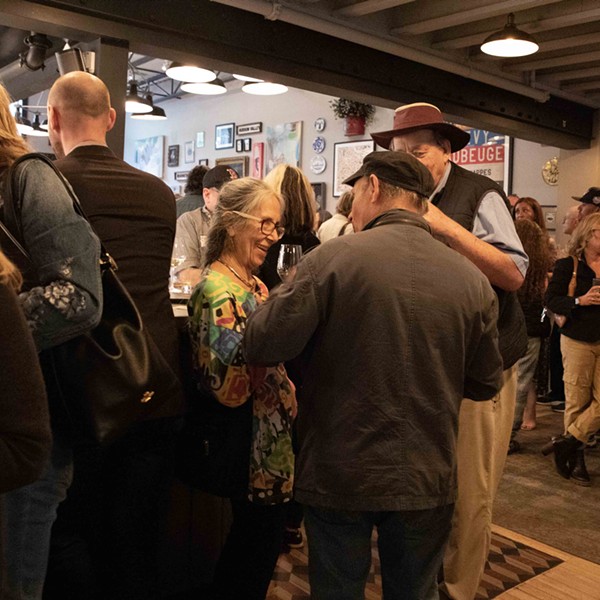To stand in the shadows of a biplane and a 19th-century Italianate mansion both, in the course of a single late-summer afternoon, does not require full imaginative immersion in a Somerset Maugham novel. Nor a time machine. A day trip to Rhinebeck—and the surrounding area—will easily accommodate your baronial (from Red to robber) flights of fancy.
Some of the most spectacular historic homes in America can be found in Northern Dutchess County—including the Locust Grove Estate in Poughkeepsie, the Vanderbilt Mansion and Franklin Delano Roosevelt’s home in Hyde Park, and the Wilderstein mansion in Rhinebeck, itself.
It would take little effort to craft of these domestic palaces and the Old Rhinebeck Aerodrome, with its collection of vintage airplanes and cars, a circuit that crackles with the optimism and glamour of the early 20th-century American “haves.” Immaculate lawns like acres-wide picnic blankets thrown down in the midst of well-maintained woods, cliff-steep views of the Hudson, paneled and lofty-ceilinged rooms inviting high society and highballs. If you can tour these sites without, even briefly, imagining yourself as a character from The Razor’s Edge, you’re a more grounded person than I.
But, of course, present-day Rhinebeck is neither a mere museum nor simply a monument to Industrial Age affluence. Rhinebeck (both the town and the village) is attractive and thriving, drawing transplants and weekenders from New York City and elsewhere, day trippers, as well as entrepreneurs and cultural presenters.
For all its activity, though, Rhinebeck’s feel is comfortable and relaxed. On a recent Sunday, the village streets were well populated with shoppers, diners, and smilingly aimless hangers out. It would be a tempting cliché to say that the village bustled; rather, it strolled. Certainly, it’s likely that some significant percentage of the crowd were out-of-towners, but the vibe was decidedly at ease and at home.
A Formerly Sleepy Town
“Well, there’s always been people here,” points out Steve Leiber, one of the founders of Upstate Films, a nonprofit film organization and theater. “And there was the aerodrome and the Dutchess County Fairgrounds. But now there are 30-plus places to eat, lots of shops, and a great variety of arts organizations. It’s pretty amazing for a one-stoplight town.”
Upstate Films was created to provide “an alternative to mainstream film exhibition” and to explore and promote “film as a medium of social communication and aesthetic experience.” It’s a daring enough mission, even now. It was all the more so when Leiber and his partners relocated from New York City in the early ‘70s. At that time, he says, Rhinebeck was a “sleepy little town.” The farming community did not trigger any prescience in Leiber and his cohorts; they weren’t certain of its eventual blossoming. It was, in fact, the town’s very quietude that provided a practical benefit, a necessity, even.
“We didn’t have anything like a traditional business plan,” Leiber says. “ We just thought, ‘Hey, let’s put on a show.’” And if the show you intend to put on is cinematic, well, plain and simple, you need a cinema. In the old Star Library building on Route 9, the aspiring group found their theater, one boarded-up and unused for years.
From the start Upstate Films’ programming was ambitious and irreverent: among the first screenings, the Marx Brothers’ one notable box-office flop, Duck Soup and Emile de Antonio’s scathing, satirical look at pre-Watergate Nixon, Millhouse. But an anecdote related on the Upstate Films’ website contextualizes the theater’s personality with a reminder of the town’s: “How rural was it in Rhinebeck? Through a phone interview snafu, Upstate’s first foreign film series became a farming film series.”
Leiber is hesitant to accept credit on behalf of Upstate Films as catalyst for Rhinebeck’s now-burgeoning cultural life. Instead he refers to the area’s indisputable natural appeal, the historic attractions, the increasing attention from real-estate-hungry city folk, and smart civic planning as elements of a “perfect storm” for the growth of the village.
He does allow, however, that Upstate Films may have functioned as an early example and anchor. “We were kind of like Army Rangers, dropped behind the lines. We’ve been really fortunate.”
Art & Commerce
Joel Weisbrod, photographer and owner of the Gazen Gallery, is a more recent arrival in Rhinebeck, though his family has ties to the region dating back to the early years of the last century. (Weisbrod’s wife’s grandfather, a Polish immigrant, came to Rhinebeck, via Pittsburgh, in 1915, to work as the town blacksmith for more than 20 years.)
Weisbrod and his wife, Linda, moved to Rhinebeck in 2005, when he retired from his Long Island-based software company. “I wanted to get away from the city rush and traffic,” he says. “That’s no retirement.”
His new home seemed at first to be just the thing. “I had the perfect life,” Weisbrod states. “I even bought a tractor.” But as much as the bucolic setting pleased him, the artistic and business opportunities appealed, as well. “I’ve been a photographer for over 30 years. I wrote a book on scuba photography. I knew I needed a gallery to show my work.” Weisbrod investigated the galleries in the Hudson Valley, between Rhinebeck and Albany, but ultimately opted for a different route. “I decided to take the plunge,” he says. The Weisbrods officially opened the Gazen Gallery in May of this year.
According to Weisbrod, the gallery’s shows are constructed to be both regionally specific and broadly popular: “Our signatures are that we only show work from artists in the Hudson Valley; that we don’t have artists of the same style in the same show—it’s not just first come, first shown; and the art is priced so that there’s something here for everybody. If I can’t sell it, I’m not going to waste the wall space.”
Conservation Tourism
In speaking of the gallery, Weisbrod sounds as much—rather more—like a savvy merchant than a stereotypical art-world guardian and guide. “I’ve been in business since I’m 14 years old,” he says. And he makes clear that he has professional ambitions for the gallery, but those goals, he says, fit within a concern for the character of his new hometown: “The only way we’re going to be successful is for Rhinebeck to become a destination in Dutchess County,” he says, implying a vision of even greater traffic in the village. But along with the retail aphorisms (“If you don’t know your clients, you don’t sell”), Weisbrod espouses a concern for responsible growth.
“Rhinebeck is just a wonderful community,” he says. “Its a lovely place to live, it’s a lovely place to raise kids, there’s lots of open space—there’s turkeys, skunks, deer on my property every day, neighbors have muskrats. Right now, this is still country.”
But Weisbrod notes, “It’s going to be hard to hold back. I worry about how much money will push people over the edge to be corrupt or selfish.”
Fear of unchecked development is common and sensible in growing communities, particularly those of rural character. But over pasta pomodoro and “skizza,” (gourmet flatbread pizzas) served in the outdoor dining area at Gigi Trattoria, it’s hard to be on edge about corruption and selfishness; possessed as one is by contentedness and satiety.
Gigi, like many of the businesses in Rhinebeck’s picturesque downtown is both upscale and unpretentious. There are cigar-store Indians outside the smoke shop; the Northern Dutchess Pharmacy has a vintage RX neon sign; the several wine stores are modestly-sized but well-stocked; the Rhinebeck Department Store has a window banner proudly declaiming its continuance of the tradition of old fashioned values. Among such quaint and reassuring emblems, it would be easy to miss the sometimes subtle indications that, despite the iconography, this is not Mayberry: the $165 price tag on the plaid work shirt at the men’s boutique Changes, the register display at Oblong Books and Music including the Tibetan Book of the Dead, and DVDs of Godard’s Pierrot le fou, and the complete work of the least-well-known member of the Monty Python troupe.
A Creative Commuity
It would be paranoiac, no doubt, to see here evidence of anything so worrisome as “corruption.” But it might not be too much to infer different tastes and sentiments than those represented by the mud-spattered monster-truck’s “Nobama” windshield decal, or the spotless white American sedan’s “Snipers: One shot, one kill,” bumper sticker. This consumer-culture semaphore just might be indicative of fundamental differences of mind among those who call Rhinebeck home (or vacation home). Though celebration artist Jeanne Fleming, for one, doesn’t seem much worried about such things.
“I think it has to do with our Dutch heritage,” she says, referring to the first nonnative settlers of the region, who arrived in the 17th century. “The Dutch were tolerant. That’s evident now in Rhinebeck. It’s an extraordinarily creative community, and it’s got all the things necessary for a lively exchange of ideas.”
Fleming is the artistic and producing director for New York’s Village Halloween Parade, a position she has held since 1981. She also organized New York City’s 1986 Harbor Festival Fair, and the Official Land Celebration for the Centennial of the Statue of Liberty, and has been behind numerous other celebration events, like the Walkway over the Hudson Walking on Air Parade on October 3. But to her Rhinebeck neighbors she is perhaps best known for organizing the 2008 winter holiday event called Sinterklaas. The idea for Sinterklaas, which is to be revived and retooled this season, says Fleming, was “a holiday celebration for children based on Dutch history.” Though the concept sounds simple enough, Fleming admits, laughing, “people said, ‘It’s never going to work. It’s never going to work!’”
Under Fleming’s direction, the town undertook a year-long preparation for Sinterklaas, which included many meetings to address the concerns of various parties about the appropriate incorporation (or omission) of religiously exclusive symbology and other sensitive issues. “It was as if Rhinebeck were a petri dish,” Fleming recalls. “It was an experiment to see if we could celebrate in a way that crossed boundaries of gender, age, ethnicity, and those separating old and new residents.”
The event was an unexpectedly massive success, receiving national media attention. (It was described as an “over-the-top success” by a writer for Huffington Post,” who added, “If you have never experienced a town fully immersed in celebration—that would be most of us—this was something magnificent to observe and participate in, just a smile away from Whoville with a hint of It’s a Wonderful Life.”)
“It was difficult and it was amazing,” Fleming says. “It was the power of being a community of people willing to let their imaginations be seized.”
On a personal level, Fleming feels this is the very point of her practice as a celebration artist: “Well, this is exactly how it works. It always starts with the problem; it ends with the transformation. There are always naysayers, but they are part of the community. So, you keep doing the work. Maybe the naysayers get transformed, maybe they don’t. Maybe they hold that place and make it safe.”
A Town Taken Care Of
Of those who dedicate much of their time and energy to advancing or protecting Rhinebeck, Fleming says with equal appreciation, “This is a town that is being taken care of.” Given the nature of Fleming’s art, community-oriented and civically engaged as it is, it’s not surprising that she can offer a historical insight that works perfectly—if ideally—as metaphor. “Did you know that Rhinebeck is one of the beneficiaries of one of the oldest private trusts in America?” she asks. “The Thomas Thompson Trust.”
As available information has it, Thomas Thompson was the shy—some say eccentric—scion of a wealthy New England merchant family. In 1845, the 48-year-old Thompson married a seamstress 30 years his junior. Together, they amassed one of the most valuable collections of art in America. Together, too, they established a trust intended to benefit, exclusively, Burlington, Vermont, and Rhinebeck. Though used initially to assist the women laborers in those locations, the will ultimately allowed for funds to be used in other “kindred charitable purposes,” including general social or civic betterment. (In the Rhinebeck area, money from the trust has been used for renovations of the historic Wilderstein mansion, for the modernization of the Northern Dutchess Hospital, for literacy programs, and to underwrite Sinterklaas.)
Mrs. Thompson was in service in Vermont. Burlington, therefore, is fitting. But Rhinebeck? Why Rhinebeck? According to the trust’s web site, there is little mystery: the Thompsons liked it. Quite simply, in Rhinebeck that leisurely product of wealth and privilege and his formerly working-class wife found something that resonated deeply with each.
RESOURCES
Dutchess County Fairgrounds www.dutchessfair.com
Enjoy Rhinebeck www.enjoyrhinebeck.com
Gazen Gallery www.gazengallery.com
Gigi Trattoria www.gigihudsonvalley.com
Oblong Books & Music www.oblongbooks.com
Old Rhinebeck Aerodrome www.oldrhinebeck.org
Rhinebeck Area Chamber of Commerce www.rhinebeckchamber.com
Rhinebeck Department Store www.rhinebeckstore.com
Sinterklaas www.sinterklaasrhinebeck.blogspot.com
Town of Rhinebeck www.rhinebeck-ny.gov
Upstate Films www.upstatefilms.org
Wilderstein www.wilderstein.org







